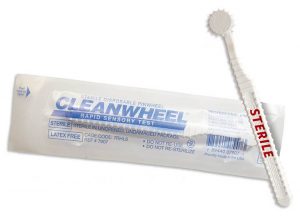CLEANWHEEL®
Sterile, Latex Free Disposable Pinwheel
A brief history
Doctors have been using neurological pinwheels for decades to test a patient’s ability to feel sensation over a particular area of skin. Loss of feeling over a “dermatome” (as these areas of skin are referred to) alert the doctors to the probability of nerve function loss, which in turn helps the doctor to determine the further diagnostic studies and/or appropriate care needed for a myriad of possible causes.
Today, doctors continue to use non-sterile metal pinwheels, safety pins or paper clips for sensitivity testing. These practices bring up serious cross-infection ramifications regarding both topical and blood-born pathogens as well as reliability concerns with patient response to testing.
LITERATURE SYNOPSIS
I quote, NEUROLOGY 1991, Vol.41:344, Fenelli, M.D., “Medical Schools should assume the responsibility of discontinuing the sale of reflex hammers with built-in pin/pinwheels in their bookstores. This, likewise applies to similar instruments used to test superficial pain sensation such as the Wartenberg pinwheel.”
In 1993, Doctor Cheyenn and Kao published the following…NEUROLOGY, Vol. 43: 1618, “Our results indicate that all neurological sensory exam instruments be used only once and then discarded properly. In this age of high HEPATITIS B VIRUS (AND HIV) prevalence and frequent litigation, we clinicians must take heed and prevent both our patients and ourselves from needless exposure.”
The patented CLEANWHEEL® is fully assembled, sterile and latex free to protect against cross-infection. Developed in compliance with OSHA’s Bloodborn Pathogen Standard, (Title 8 section 5193, California Code of Regulations) the disposable CLEANWHEEL® has its place right next to the tongue blades in every exam room, ambulance, and doctor’s bag worldwide.
NeuroChart dermatome chart, samples, and medical literature are available on request.

